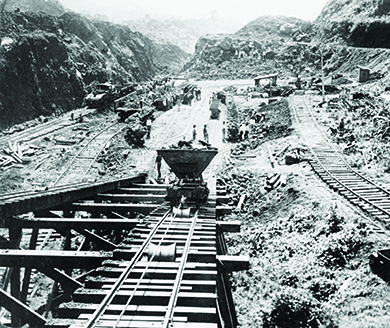| << Chapter < Page | Chapter >> Page > |
Undaunted, Roosevelt chose to now wield the “big stick.” In comments to journalists, he made it clear that the United States would strongly support the Panamanian people should they choose to revolt against Colombia and form their own nation. In November 1903, he even sent American battleships to the coast of Colombia, ostensibly for practice maneuvers, as the Panamanian revolution unfolded. The warships effectively blocked Colombia from moving additional troops into the region to quell the growing Panamanian uprising. Within a week, Roosevelt immediately recognized the new country of Panama, welcoming them to the world community and offering them the same terms—$10 million plus the annual $250,000 rental fee—he had previously offered Colombia. Following the successful revolution, Panama became an American protectorate, and remained so until 1939.
Once the Panamanian victory was secured, with American support, construction on the canal began in May 1904. For the first year of operations, the United States worked primarily to build adequate housing, cafeterias, warehouses, machine shops, and other elements of infrastructure that previous French efforts had failed to consider. Most importantly, the introduction of fumigation systems and mosquito nets following Dr. Walter Reed’s discovery of the role of mosquitoes in the spread of malaria and yellow fever reduced the death rate and restored the fledgling morale among workers and American-born supervisors. At the same time, a new wave of American engineers planned for the construction of the canal. Even though they decided to build a lock-system rather than a sea-level canal, workers still had to excavate over 170 million cubic yards of earth with the use of over one hundred new rail-mounted steam shovels ( [link] ). Excited by the work, Roosevelt became the first sitting U.S. president to leave the country while in office. He traveled to Panama where he visited the construction site, taking a turn at the steam shovel and removing dirt. The canal opened in 1914, permanently changing world trade and military defense patterns.

This timeline of the Panama Canal illustrates the efforts involved in both the French and U.S. canal projects.
With the construction of the canal now underway, Roosevelt next wanted to send a clear message to the rest of the world—and in particular to his European counterparts—that the colonization of the Western Hemisphere had now ended, and their interference in the countries there would no longer be tolerated. At the same time, he sent a message to his counterparts in Central and South America, should the United States see problems erupt in the region, that it would intervene in order to maintain peace and stability throughout the hemisphere.
Roosevelt articulated this seeming double standard in a 1904 address before Congress, in a speech that became known as the Roosevelt Corollary . The Roosevelt Corollary was based on the original Monroe Doctrine of the early nineteenth century, which warned European nations of the consequences of their interference in the Caribbean. In this addition, Roosevelt states that the United States would use military force “as an international police power” to correct any “chronic wrongdoing” by any Latin American nation that might threaten stability in the region. Unlike the Monroe Doctrine, which proclaimed an American policy of noninterference with its neighbors’ affairs, the Roosevelt Corollary loudly proclaimed the right and obligation of the United States to involve itself whenever necessary.

Notification Switch
Would you like to follow the 'U.s. history' conversation and receive update notifications?